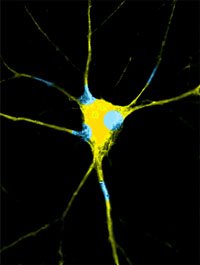Neurogenesis in Kids, Adults, and Silicon
 In the Jan '06 issue of Developmental Science, Durston et al. show a "focusing" effect of activation in frontal and precentral gyri, as well as posterior cingulate brain regions in a longitudinal study of response inhibition such that smaller surface area and yet greater signal strength is associated with increasing age. The authors point out that this increasingly focused pattern of neural activity is reflective not only of structural change (neurogenesis, pruning, myelination) but also of a complex interaction between brain structure and experience.
In the Jan '06 issue of Developmental Science, Durston et al. show a "focusing" effect of activation in frontal and precentral gyri, as well as posterior cingulate brain regions in a longitudinal study of response inhibition such that smaller surface area and yet greater signal strength is associated with increasing age. The authors point out that this increasingly focused pattern of neural activity is reflective not only of structural change (neurogenesis, pruning, myelination) but also of a complex interaction between brain structure and experience.In fact, the brain is remarkably plastic even into adulthood, such that taxi drivers grow larger posterior hippocampi the longer they've been on the job, musical proficiency in pianists and violinists is predictive of motor cortex thickness (Gaser & Schlaug, 2003), and just a few hours of phonetic discrimination training results in significant changes in the distribution and laterality of fMRI activation in perisylvian regions (Golestani & Zatorre, 2004). Neurogenesis has recently been caught in the act via a cutting-edge imaging technique known as two-photon microendoscopy. Even cannabinoids, a class of chemicals which includes the psychoactive ingredients of marijuana, have been shown to cause neurogenesis.
We can observe the same pattern of increasingly "focused" neural acitivity in artificial neural networks; as the networks are trained for specific tasks, hidden units show less diffuse activation. At the same time, some units become increasingly specialized for representing certain aspects of the task, and will thus fire more strongly than they did during the earlier diffuse activations.
This brings up several questions. What developmental mechanism determines whether task-relevant brain regions undergo pruning or neurogenesis? What is different about the situation of taxi-drivers, in which they show posterior hippocampal neurogenesis, and the situation of people trained in phonetic discrimination, in which functional reorganization and not neurogenesis occurs? And are there artificial neural network models which shed light on these questions?
There are supervised learning models of neurogenesis, such as cascade correlation among others, but it's not clear that these algorithms are biologically plausible. Recent work from Johns Hopkins suggests that neurogenesis can be a very counter-intuitive process: GABA has been seen to act as an excitatory neurotransmitter in new neurons while simultaneously serving as an inhibitory transmitter for more mature neurons! Given the confusing nature of what little we know about neurogenesis, it seems that biologically accurate models will be some ways off.
References
1) Gaser, C., & Schlaug, G. (2003). Brain structures differ between musicians and non-musicians. Journal of Neuroscience, 23 (27), 9240–9245.
2) Golestani, N., & Zatorre, R.J. (2004). Learning new sounds of speech: reallocation of neural substrates. Neuroimage, 21 (2), 494–506.


0 Comments:
Post a Comment
<< Home